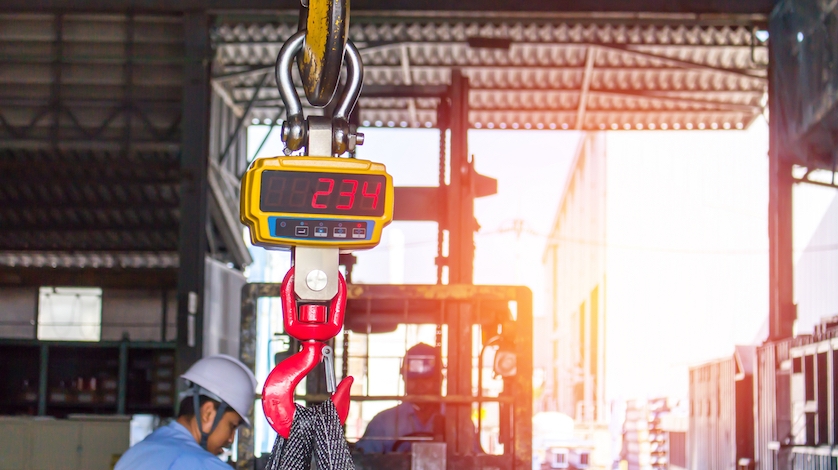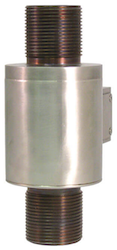
Different situations require different ways of measuring weight. To choose the right load cell for a particular application, users should consider three factors: the environment, the location, and the load itself.
From the humble bathroom scale to enormous ship-to-shore cranes, a variety of weighing technologies rely on load cells. These force transducers convert compression, pressure, tension, or torque into electrical signals, and are found in many applications:
- Food & beverage: filling machines, packaging units, price labelers
- Pharmaceuticals & biotechnology: incubators, beds, infusion pumps
- Machine building & automation: presses, stamps, robotics
- Industrial vehicles & machines: baling presses, fertilizer spreaders, livestock scales
Load cells also are used to indirectly measure level. For example, sheer beams and bending beams – two types of load cells – are installed at the base of a silo, tank, or other reservoir. Knowing the material’s weight, the container’s geometry, and other variables, one can calculate how much material is currently inside the vessel. Since the load cell does not need to be in contact with the material, this method of level measurement is particularly suitable to applications containing aggressive, steaming, foamy, or dusty media.
The Process of Choosing a Load Cell
Choosing which load cell to use is a multi-step process involving several factors. Certainly, the load cell’s measuring range, accuracy, linearity, hysteresis, and repeatability are important, but there are other key variables to keep in mind – ones that customers don’t always consider and can mean the difference between successful outcomes and disappointing performance.
When recommending a load cell, the force specialists at WIKA USA also look at the load’s characteristics, the application’s environment, and the load cell’s location in the mechanism.
1. Load characteristics
The nature of the load and how it will interact with the load cell help determine the type of load cell to use. The following are some of the questions our experts will ask:
- What type of load is being measured – bending, compression, tension, or shear?
- What type of mechanical connection is needed?
- Will the loading condition be centered or non-centered?
- Is the loading static (constant), dynamic (occurring in seconds or milliseconds), or impact (accelerating and stopping abruptly)?

F1224 mini compression load cell
These questions matter because we can recommend solutions to mitigate the effects of certain types of loads. For example, a five-pound bowling ball gently placed on a scale is static loading, and it will not overwhelm the load cell structure. However, the same ball dropped from a height of three feet can create over 1,000 pounds of force. This is dynamic loading, and it will harm load cells not designed to withstand that much force.
For a customer’s dynamic loads, we would mitigate the effects – within the realm of what is physically possible – with different designs of the load cell structure and by using a compression load cell like the F1224.

F2226 tension/ compression force transducer
2. Environmental factors
Where is the application’s physical location? Will the load cells be indoors where they are protected? Or will they be outside, constantly exposed to moisture and humidity, significant dust, fluctuating temperatures, and extreme heat or cold? These and other environmental conditions can affect load cell behavior.
Again, our experts would recommend solutions to mitigate these factors. For example, load cells for outdoor use should be made of materials with high water-corrosion resistance and have a higher ingress protection (IP) rating. Also, as load cell technology is based on the Wheatstone bridge circuit, temperature has a significant effect on the bridge’s resistance and will affect force measurement. Therefore, temperature-compensated load cells, like the F2226 tension/compression force transducer, are a must in environments subject to temperature fluctuations. All WIKA load cells have temperature compensation.
3. Load cell location
Force equipment comes in myriad sizes and arrangements. As load cells are integrated within the equipment, they have to be a certain size and geometry – all depending on how much or little space is available, and how that available space is configured.
The location will also determine which types of load cells are most suitable. For example, high-tech hospital beds can use a variety of load cells. If mounting them between each caster wheel and its attachment point beneath the bed, use bending beams/shear beams. But when the load cell will be installed between the lower and upper bedframe, planar (flat) cells are better.
Force Expertise at WIKA USA
WIKA has decades of experience in manufacturing load cells and other force measurement instruments. But our force professionals understand that high-quality components alone won’t guarantee performance. For that, you need the right load cell for the right application.
Our experts are more than happy to help customers choose the right force products for their applications. And when customization is required, WIKA has the facilities and expertise to engineer a force solution. Contact us for more information about how to choose a load cell.

